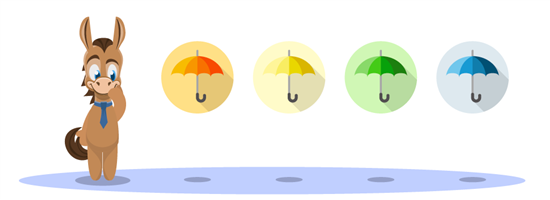Types of Life Insurance
The best type of insurance depends on your budget, what you want to cover, and for how long. Read on to learn the differences.
 |
| © CreditDonkey |
- Term Life Insurance
- Level Life
- Decreasing Term
- Additional Term Options
- Whole Life Insurance
- Traditional Whole Life
- Universal Life
- Variable Universal Life
- Equity Indexed Life Insurance
- Single Premium Permanent Coverage
- Accidental Death
- Joint Life Policies
- Single Premium and Long-Term Care Combination
- Final Expense
No one likes to talk about life insurance. Thinking about your own death is scary. But if you want to protect your family, it's a topic you cannot ignore.
Did you know that 1 out of every 3 families would be financially devastated in a month if one of the adults died?
Keep reading to learn about the difference types of life insurance that can secure your family's future should tragedy strike.
- 41% of people do not have any life insurance.
- 20% of people who have some life insurance say they don't have enough to provide for their family.
Categories of Life Insurance
There are many types of life insurance. This guide will make the different options easy to understand.
Read on to see which type is best for you.
| Features | Term Life | Whole Life |
|---|---|---|
| Duration | 1-30 Years | Life |
| Guaranteed Death Benefit | Yes | Yes |
| Death Benefit is Tax Free | Yes | Yes |
| Cash Value | N/A | Guaranteed Minimum |
| Premiums | Level until term ends | Level for life |
| Average Monthly Rate** | $33.00/mo.(20-year term) | $422.19/mo. |
| Best Suited For | Young or low budget individuals Individuals with short term debt or mortgage Parents whose children will attend college within the next 10-30 years Long term coverage needs | Long term coverage needs High budget individuals Income replacement coverage Estate tax coverage Parents wanting to leave a legacy for their heirs |
- The policy owner owns all rights to the policy and is responsible for the payments.
- The insured is the person whose life is covered.
- The beneficiary will receive the death benefit upon the death of the insured.
Term Life Insurance
 |
| © CreditDonkey |
Term life insurance covers you for a specific period. If you die within that term, the insurance company will pay out to your beneficiary. If you don't, then the policy expires. There are no extras or cash value included.
Term is the most popular type of coverage and usually the least expensive. Keep reading to learn more.
Level Term
With standard term life, also known as Level Term, you choose a length of time you want the insurance to remain in effect (the term). Terms can last 1-30 years.
During this time, your premium remains the same. The premium is higher for policies with longer terms.
A 40-year-old in good health can buy $500,000 of term insurance for less than $500 per year, which is about $42 per month. If you are younger, in your early '30s, the cost would be less than $400 per year.
Decreasing Term
A decreasing term policy has a level premium and a reclining death benefit over the length of the term. It's often less expensive than level term.
This can be a good choice if you want insurance to pay off a mortgage, student loans, or short-term debt. The death benefit declines as your loan balance declines. This way, you aren't paying for more insurance than you need.
This type of policy is good if you don't plan to move. But if you don't think you'll remain in your home for thirty years, a level term policy is a better option.
Additional Term Options
You can customize your term life policy to fit specific needs through optional riders. These include:
Convertible Term
This converts your term policy to permanent insurance without re-evaluating your health. The rider allows you to buy the amount of insurance you need at lower term rates and guarantees you will be able to change it to permanent insurance when you can afford it.
Return of Premium
If you are afraid that term life insurance may be a waste of money, consider a return of premium rider. The premiums are higher, but the amount you pay will be fully refunded if you alive until the end of the term.
Renewable Term
A renewable term rider allows you to extend your policy at the end of the term. However, the policy will renew with a higher premium every year, since you will be older at each renewal.
Types of Permanent Life Insurance
 |
| © CreditDonkey |
Permanent life insurance policies are more expensive than term insurance. But they may be better option if you need insurance long term. Read on to learn more about the types of permanent life insurance.
Traditional Whole Life
- Designed to stay in force until the insured dies, even if the insured lives until old age.
- Premiums remain the same every year.
- Premium includes a guaranteed cash value element.
- If the policy is participating, dividends may increase the value of the policy.
- The insurance company assumes the investment risk.
In traditional whole life policies, the policy contract includes a cash value table that shows what the minimum guaranteed cash value will be every year.
While the cash value cannot decrease, it has the potential for growth depending on how the insurance company's investments are doing.
Cash value works like an investment/savings account. The insurance company invests a portion of your premium and provides a portion of their returns to your cash value account.
- Reduce the premium payments
- Purchase additional amounts of death benefit coverage
- Accumulate at interest
- Taken out as a loan, with interest
Whole life policies are more expensive than term insurance, but is the better option if insurance is needed for a long time.
Universal Life Insurance (UL)
- Cash values are not guaranteed.
- Does not accumulate much cash value.
- Cash values vary based on the interest rate declared by the insurance company.
- Can be guaranteed until age 90, 95, 100, 110, 120, or 121.
- Guarantees the policy will remain in effect if minimum premiums are paid.
- Tends to have the lowest cost of the permanent insurance options.
Universal policies can be guaranteed only if at least the minimum premium payments are made.
If the insurance is needed for estate tax purposes, a guarantee that the policy will remain in effect for life is important. Policies to age 120 or 121 are guaranteed to remain in force even if you live longer than those advanced ages.
Guaranteed Universal Life to age 121 has a higher cash value than other versions.
Variable Universal Life Insurance (VUL)
- Earnings on the cash value are based on investments in the stock market.
- Choose investment options from stocks, bonds, and mutual funds
- You assume the market risk.
- The cash value and death benefit fluctuate up and down with the market.
- When the stock market is trending down, required premiums can rise significantly. You may feel additional pressure on your ability to pay the premiums.
While the death benefit can fluctuate along with the cash value, you can select a minimum guaranteed death benefit that will not change even if the interest rates are low. This may cost additional premium but will guarantee the death benefit for life.
This policy is best suited for individuals with a low investment risk tolerance looking for long-term coverage.
Equity Indexed Universal Life Insurance
- Cross between Variable Universal Life and Universal Life.
- Guaranteed minimum returns on the cash values and protections for the policy owner during market downturns.
- Caps on the gains can reduce the amount the cash value can increase by during times when the stock market is rising.
- The policy owner and the insurance company both assume some investment risk.
- Many Indexed policies have high fees.
Single Premium Permanent Coverage
- Requires one large premium that covers the cost of the insurance every year until the insured dies.
- Can be issued without a lot of medical information.
- Can be issued as Traditional Whole Life or Universal Life.
- The growth in the cash value is not tax deferred.
Other Types of Life Insurance
 |
| © CreditDonkey |
Besides term and whole policies, there are a few types of life insurance policies that may fit your needs.
Accidental Death Insurance
Accidental death insurance only pays a death benefit if death is the result of an accident. It is NOT traditional life insurance and does not include:
- Deaths resulting from high-risk activities (like driving a race car, sky diving, or deep sea scuba diving).
- Suicide
- Deaths from illnesses
Accidental death insurance shouldn't be your only coverage. Your family's financial security is not well protected since it doesn't cover death from any cause. Term insurance is a more comprehensive option.
Joint Life Policies
These policies insure the life of more than one person. While they are more expensive than a single policy, they cost less than purchasing two separate ones since only one death benefit is paid.
Joint Life policies come in two types:
- First-to-Die Joint Life.
This is great for couples who both want to provide for the other if something happens. When the first one dies, the death benefit is paid to the beneficiary. Some first-to-die policies have a convertible provision that allows the surviving spouse to purchase a single life policy without going through the underwriting process. - Second-to-Die Joint Life (Survivorship)
A Second-to-Die policy pays the death benefit after both insureds pass away.These policies can help leave an inheritance to your children and can be used to pay estate taxes. However, since nothing is paid to the surviving spouse, there is nothing to replace income which can make it difficult to keep up with the premiums.
Single Premium and Long-Term Care Combination
This hybrid policy combines long-term care with life insurance. This can cover the expenses if you ever need long-term care.
Long-term care in a nursing home, assisted living facility, or in your own home is very expensive. It can wipe out a lifetime of savings quickly.
Traditional long-term care policies are expensive. If the policy is never used, the premiums are an expense that provided no benefit other than piece of mind.
A better option is a single premium life insurance policy with long-term care benefits. The policy will pay either long-term care benefits or the death benefit. When long-term care benefits are used, the death benefit is reduced.
Final Expense Insurance
Final Expense life insurance (also called Burial Insurance) is a small whole life policy purchased to pay for funeral and burial expenses, which can cost at least $10,000.
This policy is best suited for older individuals, as you don't need a medical exam to qualify. Death benefits range from $10,000-$25,000, so the premiums are much more affordable.
How to Qualify for Life Insurance
 |
Underwriting is the process of reviewing an application and determining a rate based on many factors that might affect how long someone will live.
If you're healthy, an underwritten policy will save you money because you will qualify for better rates.
Underwriting Options
- Fully Underwritten
Fully underwritten policies are thoroughly evaluated by an underwriter, and typically require a medical exam, blood sample, and urine sample. Medical records and additional tests may be required. - Simplified Issue
These policies are recommended for individuals who are unsure of potential health issues, as they do not require a medical exam. Premiums are higher than a fully underwritten policy since the underwriter reviews less information. - Accelerated Underwriting
This form of underwriting uses Big Data to obtain necessary information and can insure people much faster.
While premiums are higher because of the lack of underwriting, the policy will be issued regardless of health.
In most cases, the insurance company will not pay a death benefit for the first 2-3 years of the contract (unless the death is accidental).
How Is Cost Determined?
Two people of the same age can have very different rates. Here are some factors that determine the cost of the policy.
- Type of Policy
Term insurance is less expensive than whole life insurance because no cash value accumulates. - Smoking
The rates for smokers are higher than for non-smokers. - Gender
Premiums for females are less expensive than males, since they generally have a longer life expectancy. - Age
Premiums on older adults are higher because they are closer to death. Premiums on very young children are at higher rates than older children. - Health
Health conditions that can reduce an individual's life expectancy, such as heart disease, cancer, and diabetes can be given a higher premium or declined altogether. - Lifestyle
Individuals who engage in risky activities such as a history of DUIs, sky diving, criminal activities, rock climbing, or travel to risky countries will receive higher premium.
BOTTOM LINE
There are many different types of life insurance. The best type for you depends on your budget, needs, what you want to cover, and for how long.
Generally, term insurance is best if you only need coverage for a specific length of time, such as to replace income for your family until retirement benefits kick in, short term debt, college tuition, and mortgage protection.
Permanent insurance is suited for those who need lifelong coverage, such as individuals with estate taxes, a business, a special needs child, or if you want to leave a legacy behind.
Write to Jeanine G at feedback@creditdonkey.com. Follow us on Twitter and Facebook for our latest posts.
Note: This website is made possible through financial relationships with some of the products and services mentioned on this site. We may receive compensation if you shop through links in our content. You do not have to use our links, but you help support CreditDonkey if you do.
|
|
| ||||||
|
|
|












